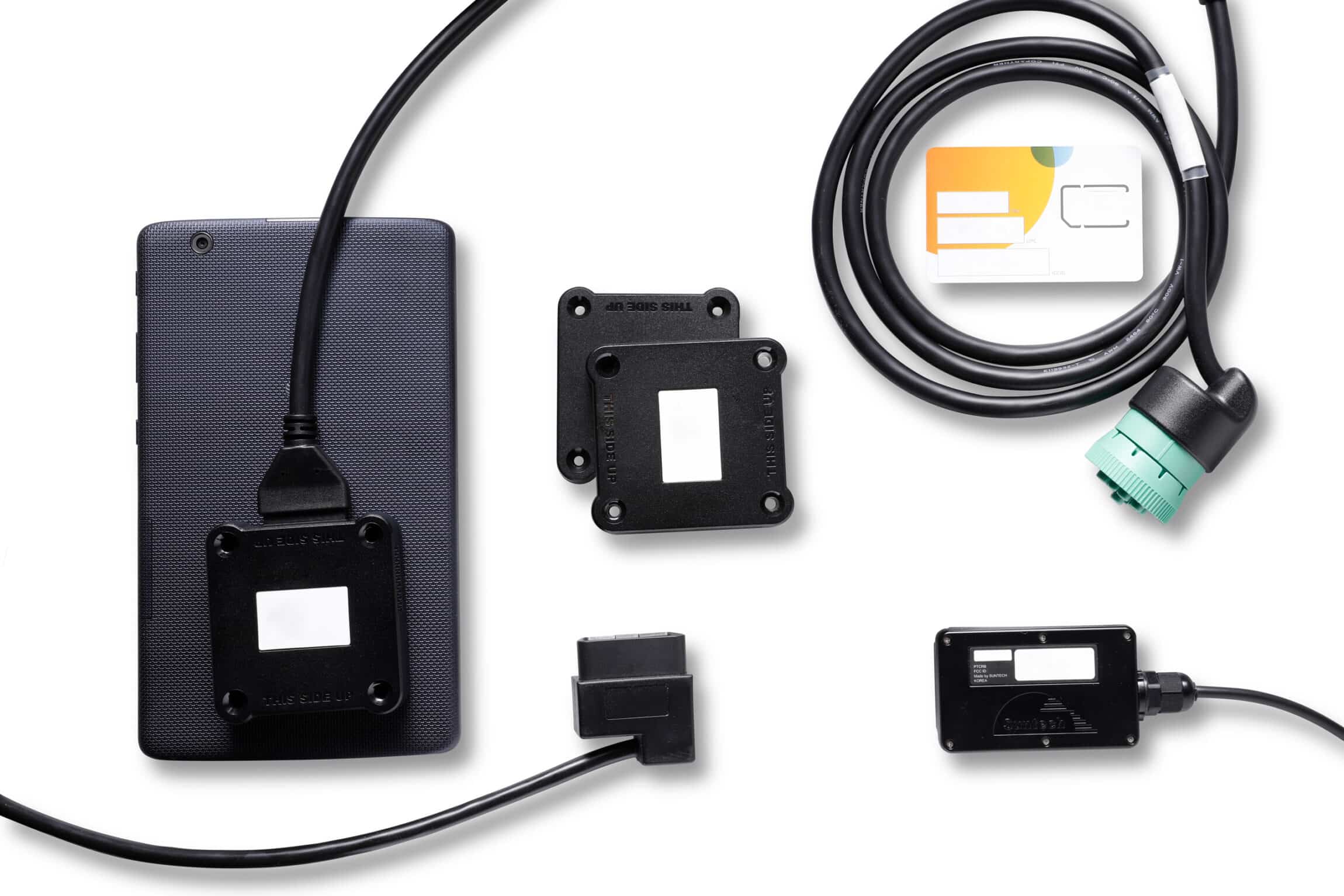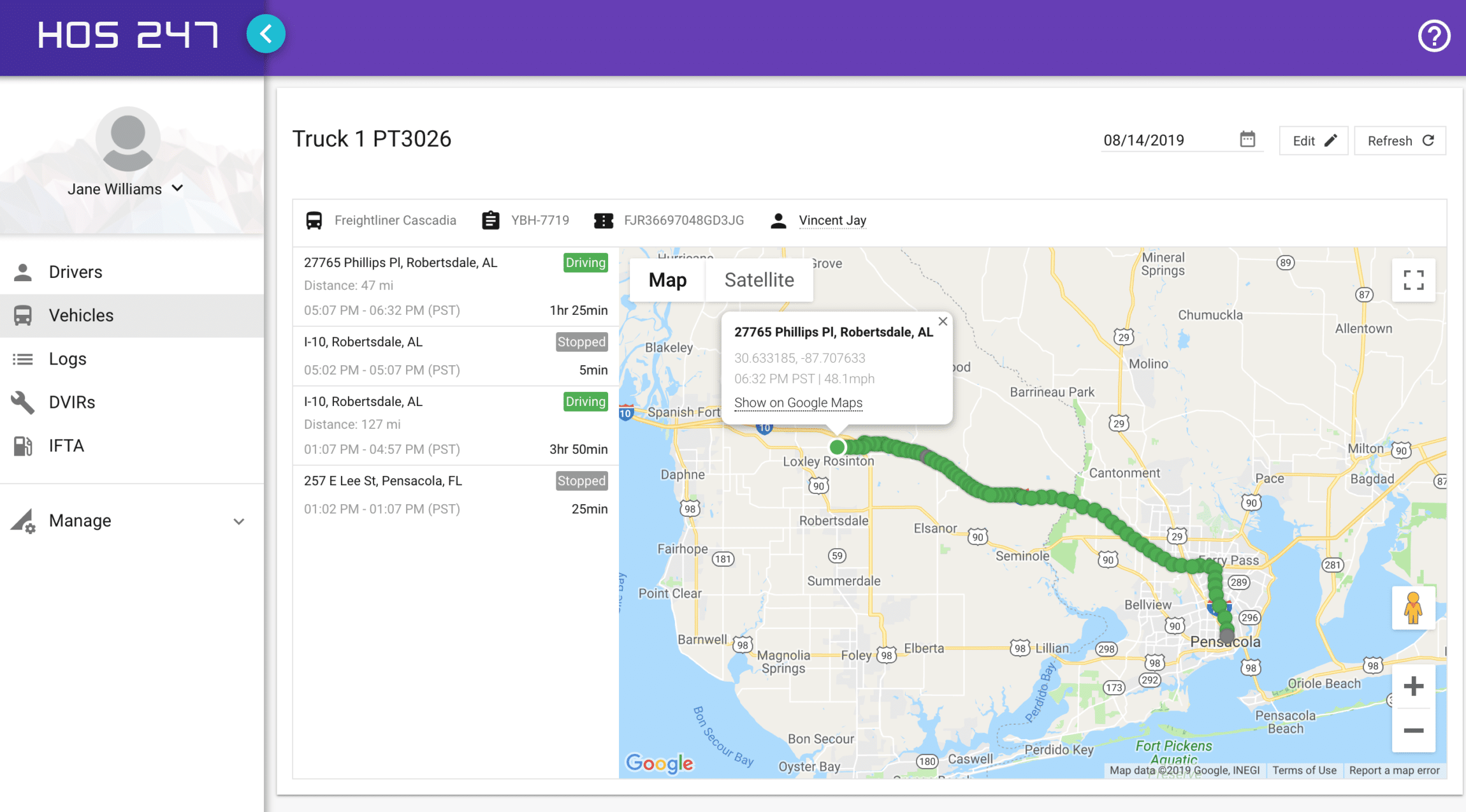GPS System for Trucks to Transform Fleet Management and Boost Profitability in Canada
Managing assets effectively is key to running a successful trucking operation in Canada. With vehicles spread out across the country, companies need reliable tools to track their fleet, stay in control, and make smart decisions. GPS fleet tracking systems have changed the way trucking companies manage their vehicles by providing real-time updates on location, performance, and usage.
These insights help businesses improve efficiency, lower costs, and deliver better service. As regulations become stricter and competition grows, fleet tracking also helps companies stay compliant and get the most value from their vehicles. Modern systems solve everyday challenges — knowing where vehicles are, making sure they’re used correctly, keeping up with maintenance, and tracking activity for both business and legal purposes.
In this article, we will go over some of the basics of fleet tracking and we will offer a guide on how to choose a GPS system for trucks that is useful for your business.
Do you have any questions? Talk to ELD Advisor: 650-405-3372 or Request Callback
Understanding GPS Tracking Systems for Trucks
Fleet tracking systems monitor vehicle locations and activities using GPS satellite technology and telematics. These systems collect data from devices installed in vehicles, transmitting information about location, engine performance, driving behavior, and other operational metrics.
The basic functionality includes:
- Asset location monitoring. Provides real-time positions of all fleet vehicles on digital maps, enabling managers to confirm vehicle whereabouts at any time.
- Historical trip data. Records routes taken, stops made, and time spent at each location, creating a complete record of vehicle usage.
- Engine diagnostics. Collection captures performance data directly from the vehicle’s computer system, identifying potential mechanical issues before they cause breakdowns.
- Activity reporting. Generates documentation of fleet operations for management review and regulatory compliance.
Fleet tracking technology has evolved significantly over the years. First-generation systems provided simple location data with limited reporting capabilities. Second-generation systems began incorporating engine data and driver behavior monitoring. Today’s systems offer fleet management platforms including compliance features, maintenance management and integration with other business systems.

Differences Between Consumer GPS and Fleet Tracking Systems
Fleet tracking systems go far beyond the basic functionality of consumer GPS devices. While consumer GPS is designed to provide simple point-to-point navigation for individual users, fleet tracking systems are built for continuous monitoring across entire fleets.
These commercial platforms collect and store detailed data on vehicle location, usage, and condition — information that supports better decision-making, regulatory compliance, and operational efficiency. Instead of just guiding drivers from one place to another, fleet tracking systems focus on how vehicles are being used, maintained, and operated.
Another key difference is integration. Business-oriented GPS systems connect with other tools such as maintenance platforms, payroll systems, billing software, and compliance reporting tools, making them a central part of fleet operations.
Most importantly, fleet tracking systems are designed to manage multiple vehicles at once. They provide real-time dashboards that give fleet managers both a broad overview and detailed insights into each vehicle’s activity, helping them stay in control and respond quickly to any issues.
Key Features of GPS Systems for Trucks
GPS fleet tracking systems provide much more than just vehicle location — they deliver the tools needed to improve efficiency, safety, and compliance across an entire operation. Let’s dive deeper into the key features that make these systems an essential part of modern fleet management:
Real-Time Asset Monitoring and Usage Optimization
Continuous visibility into fleet activity helps managers make faster, smarter decisions and ensures resources are being used effectively.
- Real-time location tracking. Shows where every vehicle is at any given moment to support faster dispatch and better customer service.
- Utilization analysis. Identifies underused vehicles so they can be reassigned or removed from the fleet.
- Historical route analysis. Uncovers inefficiencies in routes and fleet usage, revealing opportunities to do more with fewer vehicles.
Vehicle Performance and Maintenance Monitoring
These systems help reduce unexpected breakdowns and extend vehicle lifespan by tracking key performance and maintenance data.
- Diagnostic alerts. Instantly notify teams when a vehicle’s onboard system detects an issue.
- Preventive maintenance scheduling. Triggers alerts based on mileage, engine hours, or usage patterns instead of fixed calendar dates.
- Engine performance tracking. Monitors temperature, oil pressure, and other metrics to spot problems early.
- Fuel usage monitoring. Flags unusual fuel consumption that could indicate inefficiencies or mechanical issues.

Driver Performance and Safety Management
By tracking driving behaviors, fleet managers can improve safety, reduce risk, and promote better habits behind the wheel.
- Safety metric tracking. Monitors speeding, harsh braking, rapid acceleration, and sharp turns.
- Driver benchmarking, Compares performance across the fleet to set clear expectations and goals.
- Risk reduction tool. Offers feedback that helps drivers improve and holds them accountable for unsafe practices.
- Insurance benefits. May qualify fleets for lower premiums due to improved safety tracking.
Compliance and Regulatory Documentation
Automated tools built into fleet tracking systems make it easier to stay compliant with industry regulations.
- ELD integration. GPS systems for trucks can integrate with electronic logging devices to automatically log driver hours and meet Transport Canada requirements.
- Electronic vehicle inspections (DVIR). Standardizes pre-trip and post-trip inspections and stores records digitally.
- Mileage-based tax reporting. Tracks interstate travel for accurate IFTA reporting.
- Recordkeeping and documentation. Stores key compliance data to support audits, inspections, and reporting.
Together, these features make GPS fleet tracking systems a powerful tool for improving operational efficiency, reducing costs, and maintaining safety and compliance. By giving fleet managers greater visibility and control, these systems help companies stay competitive in a fast-moving industry.
Benefits of Implementing GPS Fleet Tracking
Adopting a GPS fleet tracking system brings measurable improvements to daily operations and long-term performance. By using the features outlined above, companies can experience the following benefits:
- Lower operating costs. Better route planning, reduced fuel waste, and proactive maintenance all help cut expenses across the fleet.
- Improved customer service. Real-time tracking allows for accurate delivery updates and faster response to service requests.
- Higher vehicle uptime. Scheduled maintenance and early fault detection reduce breakdowns and keep vehicles on the road longer.
- Greater driver accountability. Monitoring driving behavior helps encourage safer, more efficient habits behind the wheel.
- Stronger regulatory compliance. Automated tracking and digital records simplify the reporting process and reduce the risk of violations.
- Better use of resources. Insights into vehicle usage help managers make smarter decisions about asset deployment and fleet size.
- Reduced risk and liability. Safety monitoring and documentation offer added protection in the event of an accident or audit.
- Increased return on investment. By optimizing every aspect of fleet operations, GPS tracking helps companies get more value from their vehicles and drivers.
By making fleet operations more efficient, transparent, and responsive, GPS tracking systems offer lasting value for trucking companies of all sizes. Investing in the right solution not only supports day-to-day management but also positions businesses for long-term growth and competitiveness.

Choosing the Right Fleet Tracking System
Selecting the best GPS tracking solution starts with understanding your fleet’s specific needs and evaluating how different systems align with your operations. The right platform will not only provide accurate data but also integrate smoothly with your daily workflows.
Assessing Your Fleet’s Requirements
- Vehicle types and usage. Long-haul trucks need features like rest break monitoring and wide-area coverage, while local delivery vehicles benefit from detailed route tracking and stop analysis.
- Operating territory. Urban fleets need strong cellular connectivity, while rural or remote operations may require satellite options to avoid coverage gaps.
- System integrations. Think about how tracking data will be used. Maintenance tools rely on diagnostic data, billing systems benefit from mileage tracking, and payroll platforms can use driver hour logs.truck gps tracking system price
Key Technical Considerations
- Reliable data transmission. Cellular systems are cost-effective but may be less reliable in remote areas; satellite connectivity offers broader coverage at a higher cost.
- Update frequency. Real-time updates provide greater visibility but may use more data. Choose the right balance based on how often you need location updates.
- Durable hardware. Look for rugged devices designed to handle extreme temperatures, constant vibration, and exposure to moisture.
- Battery backup. Systems with backup power continue tracking even if the vehicle is turned off or disconnected.
Business Model and Support Considerations
- Total cost. Factor in hardware, installation, monthly service fees, data charges, and future software updates or replacements to calculate the truck GPS tracking system price for all your trucks.
- Contract flexibility. Some providers require long-term contracts, while others offer month-to-month plans that adapt to your business.
- Implementation support. A smooth setup process should include installation guidance, software configuration, and training.
- Customer service quality. Choose a provider with responsive, multi-channel support — especially if your fleet runs during nights or weekends.
Choosing a fleet tracking system is a long-term decision that impacts your daily operations, costs, and efficiency. By carefully evaluating both technical features and business support, you can find a solution that meets your current needs and grows with your fleet.

HOS247 GPS Fleet Tracking Benefits
HOS247 provides a quality GPS tracking system for trucks for companies focused on optimizing asset management and improving profitability. Our system addresses the daily challenges fleet managers face, offering both reliability and ease of use.
Comprehensive Asset Visibility
- Live vehicle monitoring. HOS247 delivers real-time location data for every vehicle, enabling dispatchers to make informed decisions based on actual vehicle positions rather than estimates. This visibility reduces the need for phone calls to confirm vehicle status and improves response times to customer inquiries.
- Detailed movement history. The platform records detailed breadcrumb trails showing each vehicle’s exact route, with precise timestamps. This data helps identify efficient routes to replicate and inefficiencies that require correction.
- Route performance analysis. The system calculates driving times and distances between stops, offering metrics to optimize territory planning and delivery schedules. This often leads to opportunities to consolidate routes and enhance asset utilization.
Advanced Fleet Management Tools
- Proactive maintenance management. Maintenance scheduling is based on actual mileage or engine hours rather than calendar dates, helping to ensure timely servicing. This approach reduces breakdown risks and extends vehicle life.
- Real-time diagnostic monitoring. HOS247 offers immediate fault code alerts, allowing fleet managers to address potential issues before they escalate. This proactive monitoring ensures problems are resolved during scheduled downtime, reducing the likelihood of unplanned repairs.
- Idle time analysis. The system identifies excessive idling patterns across the fleet, providing data to modify driver behavior and improve fuel efficiency. Addressing idle time often leads to significant fuel savings for fleets.
Streamlined Regulatory Compliance
- Automated IFTA reporting. HOS247 automatically tracks interstate mileage by jurisdiction, simplifying the IFTA reporting process.
- Electronic logging integration. Fully integrated ELD functionality automatically records driving time and locations. The system alerts drivers as they approach hours-of-service limits, ensuring compliance with Transport Canada regulations.
- Digital vehicle inspection. Electronic DVIR capabilities allow drivers to complete inspection reports quickly using mobile devices. The system maintains a history of all inspections.
- Compliance dashboard. Fleet managers have access to a comprehensive compliance overview, allowing them to track the status of all drivers. This visibility helps identify potential issues before they result in violations or penalties.
User-Centered Design
- Intuitive driver interface. The mobile app features a user-friendly design that minimizes training time and reduces the likelihood of errors. Drivers can complete required tasks with minimal distraction, improving both compliance and safety.
- Simple hardware installation. The tracking device connects directly to the vehicle’s diagnostic port and installs in minutes, without requiring specialized tools or technical knowledge. This simplicity reduces downtime during implementation.
- Cross-platform flexibility. The system works with most modern Android and iOS tablets and smartphones, allowing companies to use their existing devices or choose hardware that fits their budget and operational needs.
Business-Friendly Policies
- Flexible contract options. HOS247 offers both month-to-month and annual subscription plans, giving fleets the flexibility to adjust their investment as business needs evolve.
- Risk-free evaluation. We provide a two-week trial period, allowing businesses to test the system with their actual fleet before making a purchase decision.
- Multilingual customer support. Support is available in English, Spanish, Russian, and Polish, catering to the diverse workforce in the transportation industry.
- Callback policy. HOS247 is committed to ensuring issue resolution. If a support call drops, the team automatically follows up to address the problem, recognizing the critical nature of fleet management systems.
HOS247’s GPS fleet tracking system delivers a range of features and flexible business policies to support trucking companies in navigating their daily challenges while promoting long-term success.
Future of Fleet Tracking Technology
The landscape of transportation technology is evolving rapidly, with several emerging trends set to transform fleet asset management.
Integration with Vehicle Systems and Autonomous Features
Modern telematics systems now offer deeper integration with vehicle technology, providing increasingly detailed engine and component data that goes well beyond basic diagnostics. These advanced systems monitor a wide range of parameters — such as transmission performance, emissions systems, and brake wear — to support predictive maintenance strategies. AI-powered platforms can identify patterns in vehicle data that signal potential component failures, allowing fleets to address issues before they impact operations. This proactive approach helps schedule maintenance at optimal times, reducing unplanned downtime.
As commercial vehicles adopt more semi-autonomous features, fleet tracking systems are evolving to monitor how these technologies are being used. Data on features like adaptive cruise control, lane-keeping, and automatic emergency braking helps fleet managers understand safety performance and driver interaction with onboard systems. Some platforms are also beginning to offer remote vehicle management capabilities, enabling fleets to control functions such as door locking, engine immobilization, and cabin temperature directly from their management dashboards.
Advanced Analytics and Business Intelligence
Fleet tracking platforms are increasingly doubling as business intelligence tools. Machine learning algorithms now enable smarter route planning by forecasting traffic conditions, customer availability, and loading or unloading times with improved accuracy. These insights allow for more efficient scheduling and resource allocation. Asset utilization forecasting helps predict future vehicle needs by analyzing historical usage patterns, growth trends, and seasonal fluctuations. With this data, companies can better manage fleet size and plan for acquisitions strategically.
Comparative benchmarking is also gaining traction, allowing fleet managers to assess their operations against industry peers. These comparisons highlight strengths and identify areas for improvement. Additionally, integration with financial systems enables more accurate tracking of vehicle operating costs, factoring in everything from depreciation and maintenance to fuel and insurance. This level of detail supports smarter decisions about when to replace vehicles and which models offer the best value over time.
Enhanced Supply Chain Connectivity
Fleet tracking is becoming an essential part of the broader supply chain ecosystem, offering end-to-end visibility that extends beyond the vehicle to individual shipments or pallets. This granular level of monitoring improves cargo tracking and handling accuracy. Integration with customer portals allows shippers and receivers to access real-time tracking updates, reducing the volume of check-in calls and emails to dispatch. Automated workflows notify receiving personnel of incoming deliveries and synchronize order status with enterprise systems.
The rise of trading partner connectivity is also improving supply chain coordination. Secure data-sharing between carriers, shippers, and receivers facilitates faster communication and more agile response to exceptions. These integrated systems create a more transparent and resilient logistics network.
Sustainability and Environmental Management
As sustainability becomes a higher priority, fleet tracking technology plays an increasingly important role in helping companies meet environmental goals. Systems can now measure and report emissions based on actual fuel consumption and driving conditions, supporting both regulatory compliance and internal sustainability targets.
Fleets incorporating alternative fuel vehicles — such as electric, natural gas, or hydrogen-powered units — benefit from features that monitor battery charge status, estimate driving range, and locate available fueling or charging stations. Route optimization has also evolved to consider environmental impact alongside traditional performance metrics.
Tracking data supports idle reduction initiatives by identifying opportunities to minimize unnecessary engine run time, contributing to lower fuel consumption and emissions. Many fleets have already reported measurable improvements in fuel efficiency through these strategies.

Conclusion
Fleet tracking technology is now a key tool for trucking companies looking to boost efficiency and get the most out of their assets. These systems help manage vehicles more effectively, reduce operating costs, and stay compliant with regulations.
Modern tracking solutions offer real, measurable benefits. They can help companies use fewer vehicles by improving asset utilization, lower maintenance costs with condition-based servicing, improve driver safety through behavior monitoring, and simplify compliance by automating paperwork.
Choosing the right GPS system for truck companies depends on your fleet’s size, the areas you operate in, and how well the system integrates with your existing tools. The best solutions are powerful but also easy to use for both managers and drivers.
Providers like HOS247 offer all-in-one platforms with dependable hardware, user-friendly software, and strong customer support — so you don’t need to be a tech expert to get started.
As fleet tracking continues to evolve, companies that adopt these systems now will be better prepared for long-term success. They’ll be able to manage their fleets more efficiently, cut costs, and offer better service, giving them a clear edge over the competition.

As an expert in B2B and B2C sales, I’ve dedicated myself to perfecting sales processes and client retention strategies in the logistics and trucking industry. I have significantly contributed to the expansion of the ELD service, catering to retail and wholesale clients in need of HOS247 ELD solutions. My unwavering commitment to implementing state-of-the-art sales techniques and technologies ensures the continuous growth and success of businesses I work with.












If you are a commercial vehicle driver or a fleet manager operating in Canada, you need to comply with Transport Canada ELD and HOS rules. Many Canadian carriers also drive into the United States, where rules are enforced by the

For businesses in the transportation industry, compliance with the HOS regulations established by Transport Canada is not optional, it is a legal requirement. Before the implementation of the ELD mandate, truckers were allowed to record their hours of service manually

An ELD is an electronic logging device that keeps track of a driver’s driving hours and checks their record of duty status (RODS). It keeps accurate records by automatically updating a driver’s hours of service records. Once an electronic logging